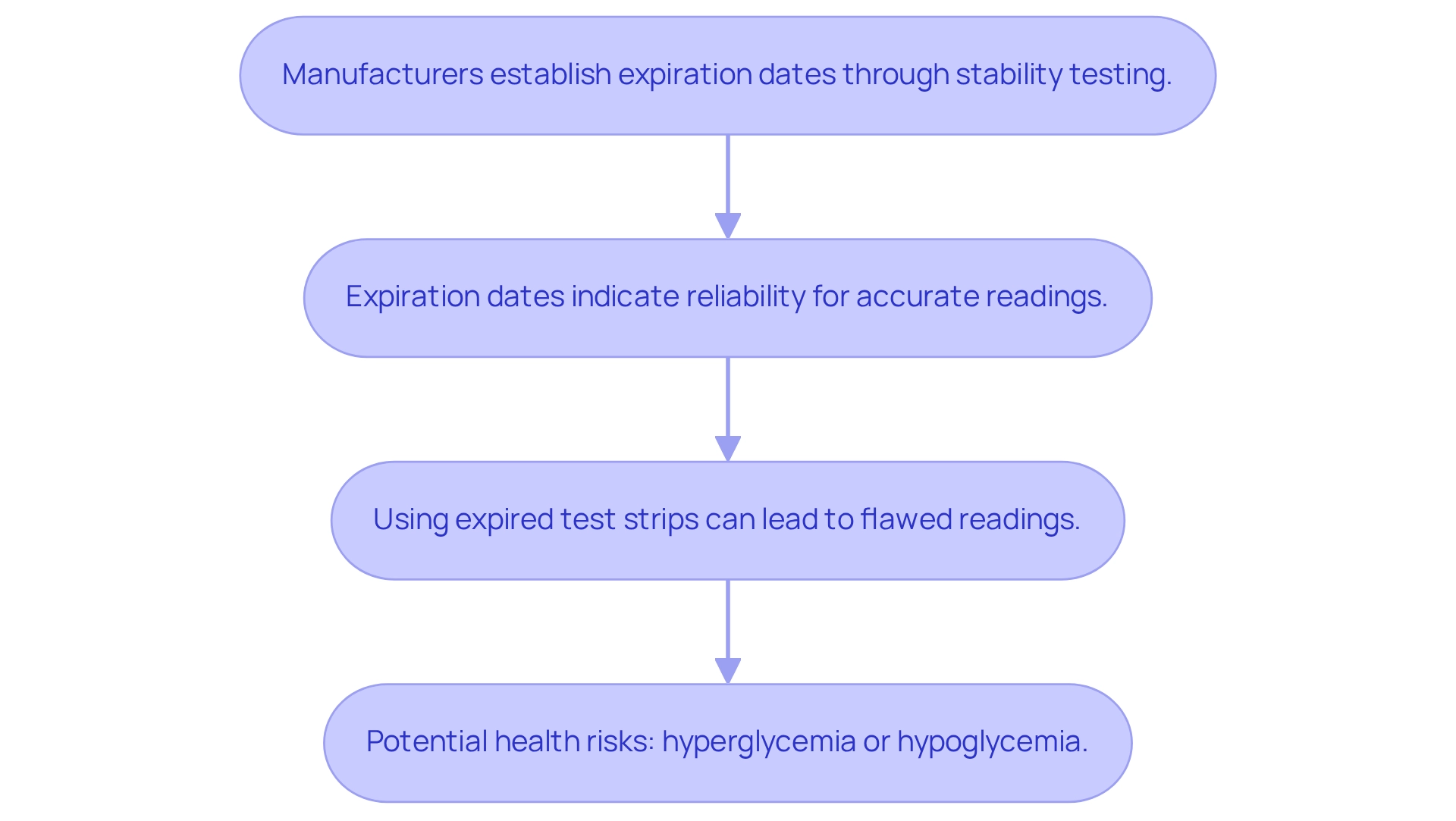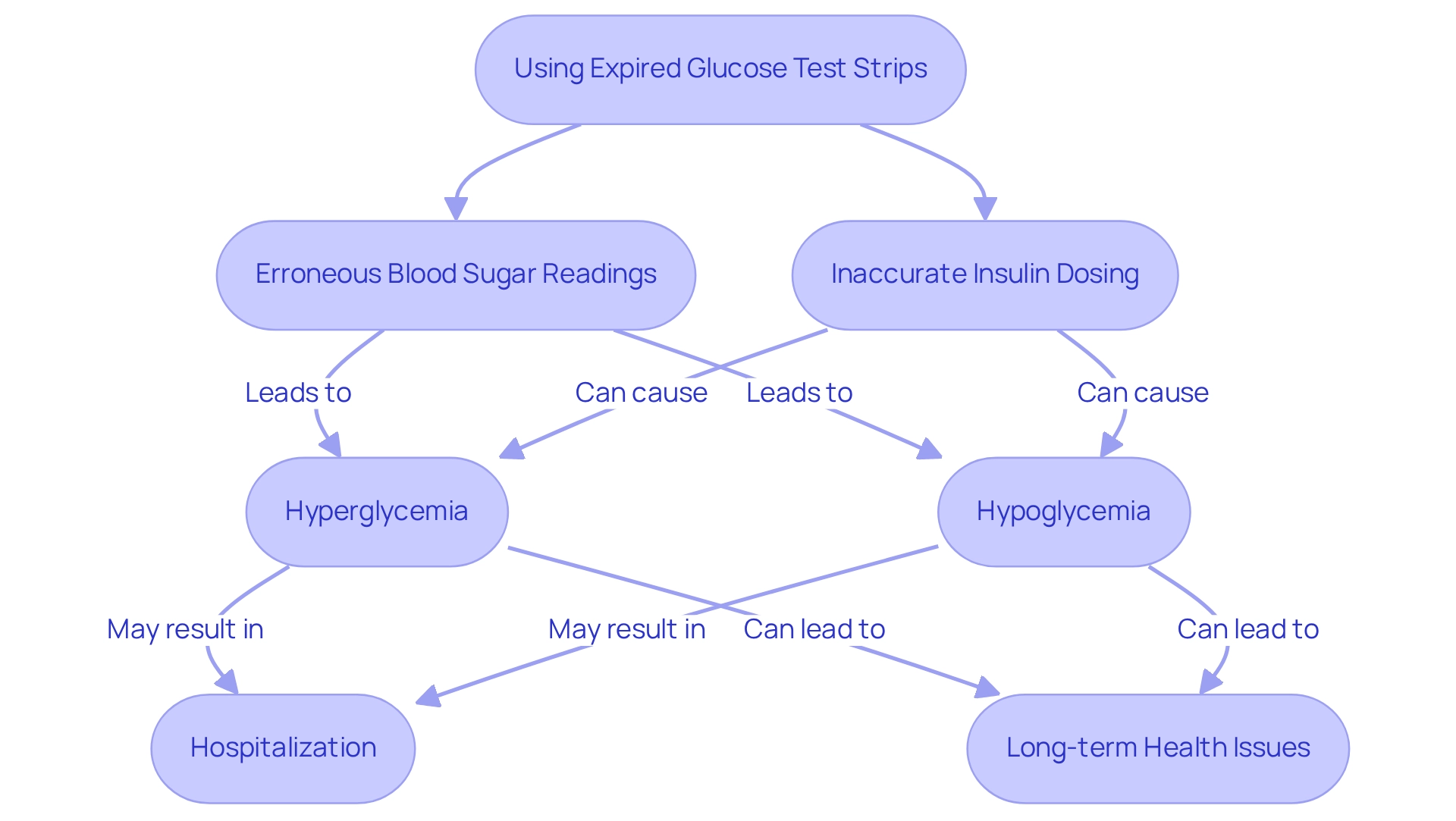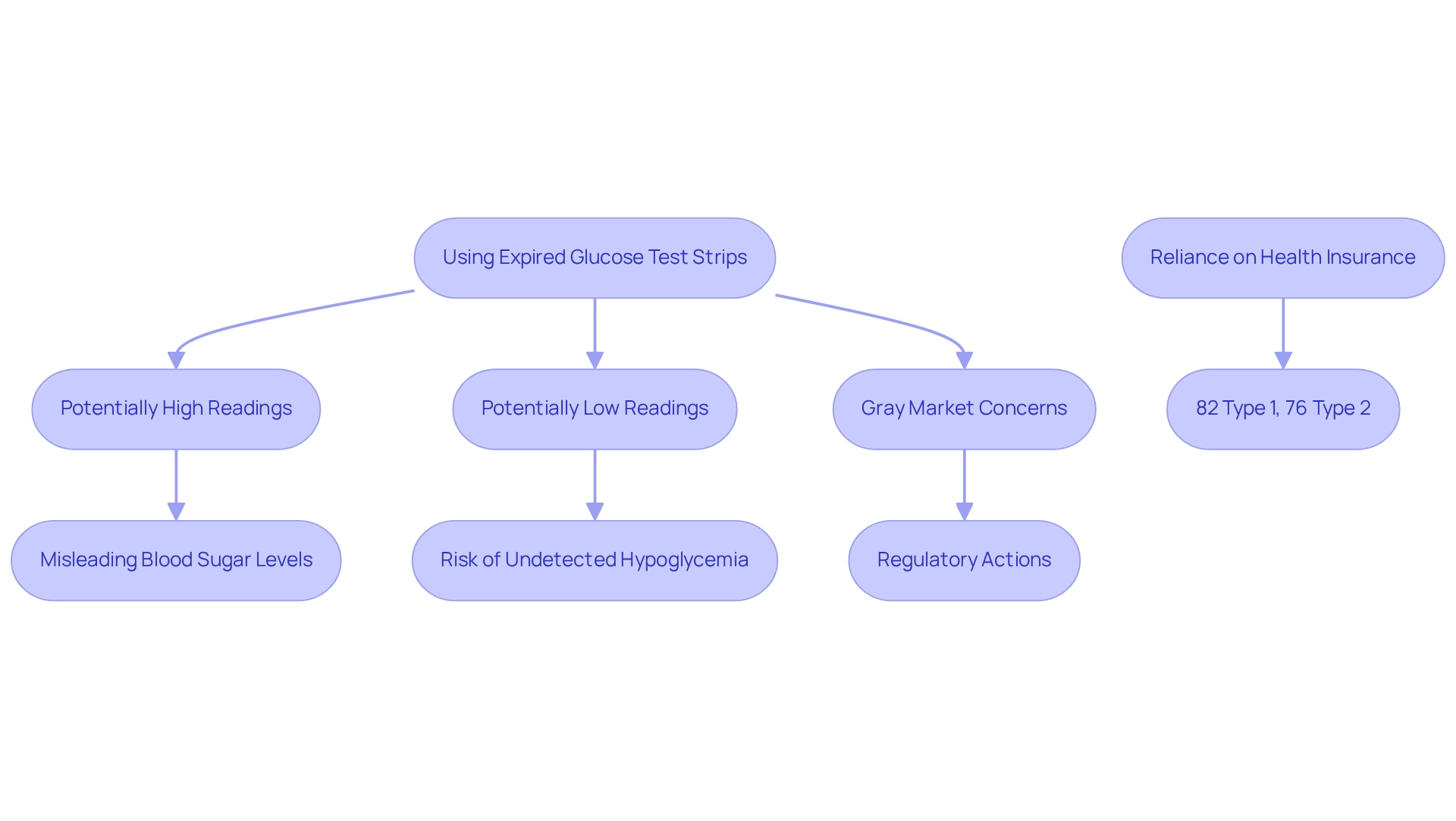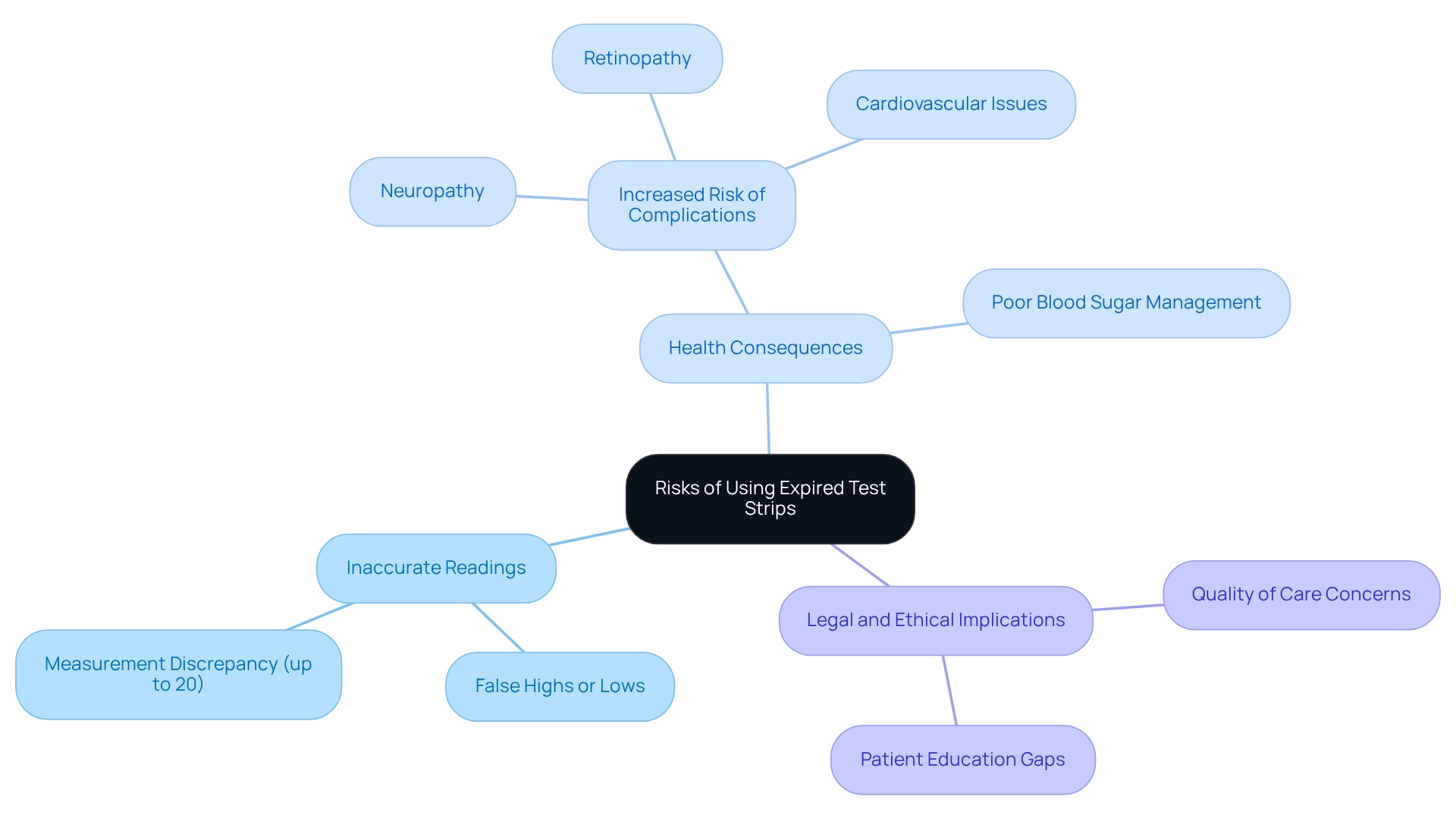Overview
Using expired glucose test strips can lead to inaccurate blood sugar readings, which may result in misguided treatment decisions. This situation can potentially worsen diabetes-related complications, and it's important to recognize this risk. Over time, these strips deteriorate, leading to inaccuracies that can mislead you into believing your blood sugar levels are stable. This misunderstanding increases the risk of serious health issues, such as hyperglycemia or hypoglycemia.
It's understandable to feel concerned about managing your blood sugar levels. Remember, you're not alone in this journey. Many individuals face similar challenges, and there are resources available to help you navigate these complexities. If you have any questions or need support, please reach out to healthcare professionals who can guide you through this process. We are here to support you every step of the way.
Introduction
In the realm of diabetes management, the precision of glucose monitoring can truly make a difference between health and serious complications. Expiration dates on glucose test strips are not just numbers; they serve as crucial indicators of reliability. Yet, many individuals may overlook their significance. It's understandable to feel overwhelmed by the complexities of diabetes care.
Research reveals that using expired strips can lead to dangerously inaccurate readings, which may result in misguided insulin dosing and adverse health outcomes. With the stakes so high, understanding the implications of these dates is essential.
This article delves into the critical importance of adhering to expiration dates, the potential health risks associated with expired test strips, and best practices for ensuring accurate glucose monitoring. Remember, you're not alone in this journey; we're here to support you every step of the way.
The Importance of Expiration Dates on Glucose Test Strips
Expiration dates on glucose testing materials are established by manufacturers through rigorous stability testing. This process assesses how long these items can maintain their accuracy and reliability. These dates serve as crucial indicators of the timeframe during which the materials are expected to perform at their best. Using test strips beyond their expiration can lead to flawed readings, which can significantly impact blood sugar management.
The FDA has highlighted the potential consequences of using expired glucose test strips, indicating that they may not provide dependable results. This could lead to adverse health outcomes for individuals who rely on these readings for critical decisions, such as insulin dosing. It's understandable to feel concerned about the implications of this.
At T2DSolutions, we recognize the importance of precise glucose monitoring as a key component of effective diabetes management. Our mission is to offer comprehensive resources and support for individuals managing Type 2 and Type 3 diabetes. Understanding the significance of expiration dates on diagnostic materials is a vital part of this journey.
Research indicates that the quality control stability of sugar measuring devices typically lasts 24 months from the production date, with an open-container stability of just 90 days. This limited timeframe emphasizes the need to adhere to expiration dates to ensure accurate blood sugar monitoring. For instance, a study assessing the OneTouch Verio Reflect blood sugar monitor revealed that 99.2% of outcomes were within ±15% of the reference standard. This highlights the importance of using reliable, non-expired measuring materials for precise readings.
The OneTouch Verio Reflect meter provides sugar results across a range of 20 to 600 mg/dL. It also features a ColorSure Dynamic Range Indicator and a Blood Sugar Mentor for personalized guidance, making it a valuable tool for your monitoring needs.
Practical examples illustrate the dangers associated with using expired glucose test strips. Patients have reported misleading sugar readings that led to inappropriate insulin administration. This emphasizes the critical need for vigilance regarding expiration dates. Moreover, expert opinions stress that using expired glucose test strips can undermine blood sugar management, as erroneous readings might lead to either hyperglycemia or hypoglycemia, both of which pose significant health risks.
As D.C.K. stated, "We hope that this study will provide objective and validated information for patients, health care professionals, and payers to make informed product selection."
In summary, the significance of expiration dates on sugar measurement devices cannot be overstated. Following these timelines is crucial for ensuring accurate blood sugar monitoring, which is essential for effective management of your condition and overall well-being. You're not alone in this journey; for further details on managing your condition effectively, including the importance of using non-expired testing materials, please visit T2DSolutions for valuable resources and support.

Health Risks of Using Expired Test Strips
Using outdated glucose measuring devices can pose significant health risks, especially when considering the implications of using expired glucose test strips. Erroneous blood sugar readings can lead to inappropriate insulin dosing, resulting in either hyperglycemia (high blood sugar) or hypoglycemia (low blood sugar). Both conditions carry serious health implications, including the risk of hospitalization and long-term complications such as cardiovascular issues and nerve damage.
Expired test strips may not react properly with blood samples, which complicates blood sugar management. For individuals facing Type 2 and Type 3 conditions, the repercussions of mismanagement can be particularly severe. It's understandable to feel overwhelmed by these challenges. A recent trial highlighted that daily blood glucose monitoring (BGM) did not improve glycemic outcomes or quality of life for many patients, emphasizing the importance of accurate readings in effective care.
The Re-Think the Strip Implementation Project serves as a relevant case study, showing how unnecessary daily testing affects patient care. This initiative aimed to reduce the frequency of daily blood sugar monitoring for patients with Type 2 who do not require insulin. Studies indicated that such testing does not offer benefits in managing the condition or enhancing quality of life. Initially, the project reduced unnecessary glucose monitoring prescriptions in 20 primary care clinics in North Carolina, but after 18 months, prescription rates returned to previous levels, highlighting the ongoing challenges in diabetes management.
The health risks associated with using expired glucose test strips are amplified by the potential complications from inaccurate blood sugar measurements. Diabetes experts caution against relying on outdated testing materials, as they can lead to significant errors in treatment strategies. For instance, a patient depending on inaccurate readings might inadvertently administer too much insulin, resulting in hypoglycemia, or too little, leading to hyperglycemia.
Dr. Howard Wolpert, a researcher in glucose management, emphasizes that "technology and other advancements transforming care for diabetes" highlight the need for precise monitoring tools.
In summary, using expired glucose test strips can jeopardize the management of blood sugar conditions. It's essential to regularly check the expiration dates of your testing supplies and seek reliable alternatives to ensure accurate monitoring. Remember, you’re not alone in this journey. Cultivating a community of support and shared knowledge, as advocated by T2DSolutions, can lead to improved health outcomes and empower individuals in their management journey.
For more information on diabetes management and to stay updated on resources, we encourage you to visit T2DSolutions.

Accuracy Concerns: Do Expired Test Strips Read High or Low?
Using expired glucose test strips can lead to inconsistent and potentially hazardous outcomes when testing blood sugar. It's important to understand that the enzymes in these materials deteriorate over time, which significantly alters their chemical interactions with sugar. For example, studies show that expired glucose test strips may produce inaccurately high readings, misleading users into thinking their blood sugar levels are higher than they truly are.
Conversely, some outdated materials might underestimate sugar levels. This raises a valid concern about the implications of using expired glucose test strips, as it could increase the risk of unnoticed hypoglycemia.
A significant case study highlights the emergence of a gray market for sugar measurement devices, where products are often resold at lower prices. However, the quality and safety of these items can be questionable, raising concerns about potential fraud and the risks associated with using expired goods. This gray market underscores the importance of caution when purchasing from unofficial sources.
Regulatory actions are being considered to ensure patient safety and prevent fraud in the supply chain of related products.
Statistics reveal that a considerable share of individuals with diabetes rely on health insurance for their testing materials. Specifically, 82% of those with type 1 and 76% of those with type 2 diabetes obtain their supplies through insurance. This reliance emphasizes the need to address coverage constraints and cost-sharing options with healthcare professionals to secure reliable monitoring solutions.
Given the inconsistencies that can arise from using outdated blood sugar testing materials, it's vital for individuals managing their health to understand the implications of using expired glucose test strips. This knowledge ensures precise monitoring and effective management of their condition. At T2DSolutions, we aim to be a supportive resource for individuals navigating their health journey, offering guidance on the safe use of blood sugar monitoring devices and other essential tools. The American Diabetes Association recommends that most non-pregnant adults with diabetes strive for an A1C level of less than 7% or 154 mg/dL, reinforcing the importance of accurate monitoring in achieving optimal health outcomes. You're not alone in this journey, and we are here to support you every step of the way.

Legal and Ethical Considerations of Expired Test Strips
The sale and use of outdated glucose measuring devices present significant legal and ethical challenges that can deeply affect individuals managing diabetes. While selling expired items may not be explicitly illegal, it raises serious ethical concerns—especially when vendors do not disclose the expiration status to buyers. The FDA strongly advises against using expired evaluation materials, highlighting the potential risks involved with expired glucose test strips, as their safety and effectiveness cannot be guaranteed.
This situation is particularly concerning for individuals with diabetes, who depend on accurate monitoring for effective disease management. It's understandable to feel anxious about the implications of using outdated testing tools.
Legal ramifications surrounding the sale of outdated blood sugar monitoring materials are considerable. For instance, healthcare providers might face liability issues if patients experience negative health impacts due to reliance on inaccurate readings from expired tests. Moreover, ethical dilemmas often arise in clinical settings, where providers must navigate the delicate balance between cost-saving measures and patient safety.
A case study examining medication disposal practices in Iraq revealed a significant gap between public awareness of safe disposal methods and actual practices. This underscores the urgent need for better education on the implications of using expired medical supplies. Such gaps reflect the ethical concerns regarding the use of expired glucose test strips, emphasizing that the responsibility for safe practices must be shared among healthcare providers and patients alike.
Additionally, ethical issues encompass the potential dangers faced by at-risk groups, including individuals struggling with blood sugar regulation. These individuals rely on dependable monitoring tools to manage their health effectively. The duty rests with both healthcare providers and patients to ensure that management supplies are current and reliable.
As Dr. Dhia Jabbar Kadhim, head of the Clinical Pharmacy Department at the University of Baghdad College of Pharmacy, emphasizes, "Proper disposal and management of medical supplies are crucial for patient safety and public health." By fostering a culture of transparency and accountability, the healthcare community can better protect patients and enhance overall health outcomes. Initiatives like the implementation of Snap&Go at Sourasky Medical Center showcase effective management practices that prevent the use of expired medical supplies, reinforcing the importance of having up-to-date and dependable tools for managing health conditions related to blood sugar.
By collaborating, we can ensure that individuals with diabetes-related conditions have access to the necessary resources for effective care. Remember, you're not alone in this journey; we are here to support you every step of the way.

What to Do Instead: Safe Practices for Blood Glucose Monitoring
At T2DSolutions, we genuinely care about being a comprehensive resource hub for individuals managing Type 2 and Type 3 conditions. Understanding what happens if you use expired glucose test strips is essential for ensuring accurate blood glucose measurement. By adopting safe practices, you can significantly enhance your diabetes management.
- Regularly Check Expiration Dates: It’s important to consistently verify the expiration dates on your testing materials. Disposing of any that are outdated helps avoid incorrect readings.
- Appropriate Storage: Keeping examination bands in a cool, dry setting is crucial for maintaining their efficacy. Remember, exposure to moisture or extreme temperatures can compromise their integrity.
- Consider Continuous Glucose Monitors (CGMs): Using a CGM can be a wonderful alternative to traditional test strips. These devices offer real-time sugar readings, reducing the need for frequent finger pricks and providing a more complete perspective of sugar variability. Recent studies have shown that CGMs can enhance clinical decision-making by incorporating both point accuracy and the rate of change in blood sugar levels.
The Continuous Glucose-EGA (CG-EGA) framework, a new metric for evaluating CGM data, allows for a more comprehensive assessment of glucose variability, which can improve your understanding and management of diabetes.
- Consult Healthcare Providers: If you suspect your test strips may be compromised, please reach out to your healthcare provider for guidance on obtaining new supplies.
By following these best practices, you can effectively manage your condition and mitigate the risks associated with expired glucose test strips. Statistics indicate that modifications to antidiabetic treatment are essential if blood sugar levels drop below 3.9 mmol/L (70 mg/dL), underscoring the importance of accurate monitoring. Additionally, expert recommendations emphasize the need for regular monitoring and the use of reliable testing methods to ensure optimal health outcomes.
As Boris Kovatchev, Ph.D., noted, creating metrics for assessing CGMs is vital for improving the management of blood sugar conditions, supported by substantial research funding. At T2DSolutions, we are here to provide you with the essential tools and assistance you need to navigate your health journey effectively.

Key Takeaways: The Risks of Using Expired Test Strips
Using outdated glucose measurement materials can pose serious health risks, especially when considering the implications of using expired glucose test strips. Such actions can lead to inaccurate blood sugar readings, which may result in misguided treatment decisions. This raises the important question of what happens if you use expired glucose test strips, potentially worsening diabetes-related complications. Expiration dates are vital indicators of a device's reliability; ignoring them can significantly undermine effective diabetes management.
It's concerning that many individuals may overlook expiration dates. This can lead to skewed results with dire consequences. For instance, research shows that using expired glucose test strips can cause measurements to differ by up to 20%. This discrepancy can mislead patients into believing their blood sugar levels are stable when they are not. Adhering to expiration guidelines is crucial, much like the educational activity on retinal disease that stresses the importance of timely updates and best practices, which expires on May 31, 2025.
Key takeaways regarding the risks of using expired glucose test strips include:
- Inaccurate Readings: Expired strips may not function correctly, resulting in false highs or lows in blood sugar readings.
- Health Consequences: Ignoring expiration dates can lead to poor blood sugar management and increase the risk of complications such as neuropathy, retinopathy, and cardiovascular issues.
- Legal and Ethical Implications: Using expired supplies raises concerns about the quality of care, particularly in clinical settings.
Expert insights emphasize the importance of adhering to expiration dates for medical supplies. Ruth S Weinstock from the Department of Medicine at SUNY Upstate Medical University states, "These results strongly suggest that more attention to periodically reviewing and re-educating patients concerning proper insulin self-administration should be considered, and this may be particularly important for those with lower income and education levels." Medical professionals advocate for regular evaluations of blood sugar management methods, including the timely replacement of monitoring materials.
This proactive approach not only enhances the accuracy of blood glucose monitoring but also supports better overall health outcomes.
Real-world examples highlight the consequences of neglecting expiration dates. Many individuals wonder what happens if you use expired glucose test strips, as they report experiencing hypoglycemia or hyperglycemia due to inconsistent readings. This underscores the essential need for caution in blood sugar management.
In conclusion, prioritizing the use of current test strips and following recommended guidelines is crucial for effective blood sugar management. By doing so, you can significantly reduce the risks associated with expired supplies and protect your health. For more resources and updates on diabetes management, consider subscribing to t2d solutions, your comprehensive hub for Type 2 and Type 3 diabetes education and community support. Remember, you're not alone in this journey, and we are here to support you every step of the way.

Conclusion
Using expired glucose test strips can pose significant risks that may jeopardize your diabetes management. It’s crucial to rely on these strips for accurate blood sugar readings, as inaccuracies can lead to misguided insulin dosing, resulting in potentially dangerous health outcomes like hyperglycemia or hypoglycemia. Remember, adhering to expiration dates is not just a guideline; it’s an essential practice that ensures the reliability of the monitoring tools you depend on daily.
Expired test strips can produce misleading results, which may lead to severe complications and undermine your overall health. Real-world examples highlight the consequences of neglecting these dates, reinforcing the need for vigilance in your monitoring practices. Additionally, the legal and ethical implications surrounding the sale and use of expired strips underscore the shared responsibility between healthcare providers and patients to ensure safety and efficacy in diabetes care.
In summary, prioritizing the use of current glucose test strips and implementing safe monitoring practices is vital for maintaining your optimal health. By regularly checking expiration dates, properly storing your supplies, and consulting healthcare professionals when necessary, you can significantly enhance your diabetes management journey. Remember, you’re not alone in this journey; accessing valuable resources and support from organizations like T2DSolutions can empower you to make informed choices, ultimately leading to better health outcomes and a more effective approach to managing diabetes.
Frequently Asked Questions
Why are expiration dates important for glucose testing materials?
Expiration dates indicate the timeframe during which glucose testing materials, such as test strips, are expected to maintain their accuracy and reliability. Using materials beyond their expiration can lead to flawed readings, significantly impacting blood sugar management.
What are the potential consequences of using expired glucose test strips?
The FDA has warned that expired glucose test strips may not provide dependable results, which could lead to adverse health outcomes, such as incorrect insulin dosing. This can result in hyperglycemia (high blood sugar) or hypoglycemia (low blood sugar), both of which carry serious health risks.
How long do glucose measuring devices typically last?
Research indicates that the quality control stability of glucose measuring devices generally lasts 24 months from the production date, while open-container stability is limited to 90 days.
What is the significance of using non-expired glucose test strips?
Using non-expired test strips is crucial for obtaining accurate blood sugar readings, which are essential for effective diabetes management. Erroneous readings can lead to inappropriate insulin administration and serious health complications.
Can expired glucose test strips affect blood sugar management?
Yes, expired test strips may not react properly with blood samples, complicating blood sugar management and potentially leading to mismanagement of diabetes, particularly for individuals with Type 2 and Type 3 conditions.
What does the Re-Think the Strip Implementation Project indicate about glucose monitoring?
This project showed that unnecessary daily blood glucose monitoring does not improve glycemic outcomes or quality of life for many patients, emphasizing the importance of accurate readings in diabetes care.
What should individuals do to ensure accurate blood sugar monitoring?
Individuals should regularly check the expiration dates of their testing supplies and seek reliable alternatives to ensure accurate monitoring of their blood sugar levels.
Where can individuals find more resources and support for diabetes management?
T2DSolutions offers comprehensive resources and support for individuals managing Type 2 and Type 3 diabetes, including information on the importance of using non-expired testing materials.
